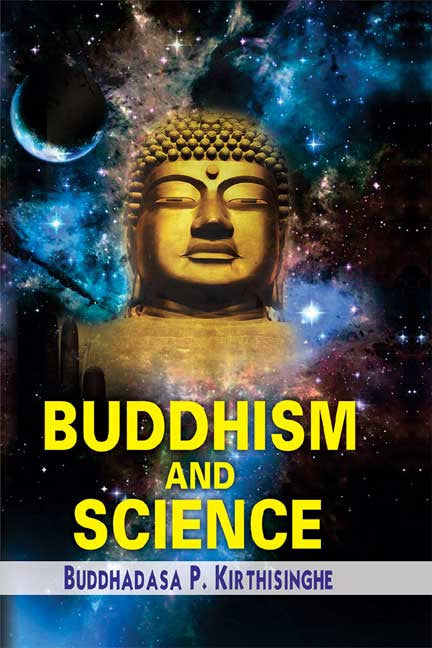Buddhism and Science
Buddhism and Science - Paperback is backordered and will ship as soon as it is back in stock.
Couldn't load pickup availability
Buddhism and Science is a compilation of a few learned articles on the subject. Dr. Buddhadasa P. Kirthisinghe, who is the Editor as well as one of the principal contributors, is a well known interplanetary biologist and evolutionary scientist having had more than 30 years' experience of exploring scientific knowledge, during which time he has also done Dharmaduta work in the West particularly in North America. It is fortunate that a man with such a vast legacy has been able to coordinate modern scientific thought with the Buddha Dharma. He has shown remarkably well how the revolutionary theories of Charles Darwin and others blend with the Dharma (Buddha's teachings). Neither the evolutionists nor the Buddhists recognize that the world, or even the mighty universe, was created by god. Thus, the rejection of an Atta (soul) by the Buddhists, fascinates the evolutionists: if man has a soul, then the animal should have had it first, they claim.
Professor Fred Hoyle of Cambridge University believes in a steady state of the universe, with no beginning and no end. These concepts have fascinated the Buddhists from very early times. The ancient concepts that life exists on other planets, sometimes in higher or lower forms, are also accepted by modern astronomers. Some cosmologists believe our own galaxy has over 300,000,000 civilizations, which confirms Buddhist beliefs, modern and ancient.
Gerald Du Pre has shown how the Buddhist philosophy of Anicca (impermanence), Dukkha (suffering), and Anatta (egolessness) blends with modern science, with remarkable clarity.
Upasaka Wu Shu (Dr. Loo Yung Tsung), a great physicist, states that atomic science and Buddhism seem to be entirely different, yet they are tackling the same problem of energy and releasing of energy, breaking the highly concentrated form of energy, the so-called atom, in one case, and ego, in the other.
Dr. Shanti Tayal, a practising psychotherapist trained both in India and in the USA, states that many early mental diseases can be controlled by practising the Buddha's Middle Path, recognizing the Four Noble Truths, and gradually practising the Eightfold Noble Path. Many psychiatrists recommend meditation to people suffering from mental troubles.
Review(s)
"Buddhism and Science", a collection of articles by several writers edited by Dr. Buddhadasa Kirthisinghe, is an attempt to look at Buddhism through this newer way of thinking. The main focus of all these articles is to discuss how relevant Buddhism is in regards to the modern knowledge.
....Along with psychology this book discusses subjects such as genetics, cosmology, nuclear physics in relation to Buddhism. Altogether there are 23 articles written by experts in these various areas and Buddhism.
....the articles have the potential of making the reader look at Buddhism in a different angle. - Ven. Seeliwamala, Wheel of Dharma, Vol.12, May, 1985; Issue 5
Dr. Buddhadasa P. Kirthisinghe....a well known interplanetary biologist and evolutionary scientist....has shown remarkably well how the revolutionary theories of Charles Darwin and others blend with the Dharma (Buddha's Teachings).
Professor Fred Hoyle of Cambridge University believes in a steady state of the universe, with no beginning and no end. These concepts has fascinated the Buddhists from very early times....Some cosmologists believe our own galaxy has over 300,000,000 civilizations which confirms Buddhist beliefs, modern and ancient.
Gerald Du Pre has shown how the Buddhist philosophy of Anicca (impermanence), Dukkha (suffering), and Anatta (egolessness) blend with modern science, with remarkable clarity.
Upasaka Wu Shu (Dr. Loo Yung Tsung), a great physicist, states that atomic science and Buddhism seem to be entirely different, yet they are tackling the same problem of energy and releasing of energy, breaking the highly concentrated form of energy, the so-called atom, in one case, and ego, in the other.
Dr. Shanti Tayal, a practicing psychotherapist trained in the U.S.A. states that many early mental diseases can be controlled by practicing the Buddha's Middle Path, recognizing the Four Noble Truths, and gradually practicing the Eightfold Noble Path. - World Fellowship of Buddhist, Vol.xxii, No.1, Jan-March 1985
About the Author(s)
-
Pages
-
Edition
-
Size
-
Condition
-
Language
-
Weight (kg)
-
Publication Year
-
Country of Origin
-
Territorial Rights
-
Reading Age
-
HSN Code
-
Publisher




